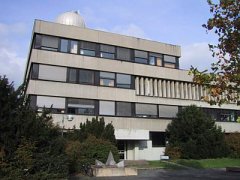
- Quick links:
- German ALMA Community Day 2025
- Announcement for early proposal planning
- Proposal Preparation Support: Online Resources
- Dual-anonymous Guidelines
- Information on the proposal review process
- LEGO ALMA - Radiointerferometrie verstehen leicht gemacht
- ALMA Status Page
- ALMA Configuration Schedule
- The German ARC node:
- Home
- About us
- Visiting us
- Contact
- ARC staff
- Newsletter
- Host institutes:
- University of Bonn
- University of Cologne
- Impressum
- Datenschutzerklärung
- The European ARC:
- ALMA at ESO
- European ALMA Regional Centre
- ALMA Science Portal
- ALMA Helpdesk
- European ARC nodes:
- German node
- Allegro (Dutch node)
- Italian node
- U.K. node
- Nordic node
- IRAM node
- Czech node
- External links:
- ALMA for the public
- ALMA at the NA ARC
- ALMA at the EA ARC
About the German ARC node
The German node of the ALMA Regional Center was established as
one initiative of the Research Association for Interferometry in
North Rhine-Westphalia ("NRW Forschungsverbund
Astro-Interferometrie"), which was founded in 2004 in order to
strengthen and coordinate the technological, scientific and
educational efforts relating to radio and
infrared interferometry between the neighboring astronomical
groups of Bonn and Cologne. It builds upon a long
history of collaboration between the Universities of Bonn and Cologne, and the Max Planck Institute for
Radioastronomy in research, education and instrument
development.

The ARC node team in Bonn and Cologne provides face-to-face support to ALMA users, giving assistance during all stages of an ALMA project including the proposal preparation, observing set-up as well as the data reduction stages. In addition, we offer support in the following specialized areas of expertise:
Zero-spacings and data combination
Our team in Bonn has extensive experience with single-dish data and is actively involved in the development of tasks to combine single-dish and interferometric data. A GUI for flexible data feathering in the image plane has been developed and we further focus on multi-scale data analysis to be used for ALMA imaging. We are also part of the European ALMA Imaging group and provide face-to-face support for imaging issues.
mmVLBI with ALMA
Since Cycle 4 (October 2016 - September 2017), it is possible to request the phased ALMA array to be included in global mmVLBI observations at 3mm (GMVA) and at 1mm (EHTC). ARC node staff in Bonn has collaborated closely with the MPIfR and other international partners on a detailed operations plan and supported the actual implementation of the first PI-led mmVLBI observations in spring 2017. We continue to offer support to ALMA users interested in using ALMA in mmVLBI mode.
CDMS database
The University of Cologne is responsible for the management, maintenance and upgrade of the Cologne Database for Molecular Spectroscopy (CDMS). This catalog contains predictions on frequency transitions and line parameters such as line intensity and hyperfine emission for atoms and molecules of astrophysical and atmospheric interest. Together, the Cologne and Jet Propulsion catalogues (CDMS and JPL) are the most important secondary resources for molecular data of radio astronomic interest. In order to combine both catalogues, and to adequate their structure to modern applications, CDMS became one of the molecular data centers within the European project VAMDC (Virtual Atomic and Molecular Data Center). The transition from CDMS to VAMDC is essentially complete and has been tested. In the framework of the ARC node, we maintain and upgrade the database, and provide interfaces and tools for astrophysical users.
XCLASS and MAGIX
The University of Cologne also leads the development of a toolset (eXtended CASA Line Analysis Software Suite, XCLASS) to do ALMA data analysis by using the information stored in the CDMS database. The XCLASS software is a toolbox for the CASA package aimed at identifying and fitting astronomical spectral line data. The toolbox contains an interface for the model optimizer MAGIX which helps to find the best description of the data using a certain model. XCLASS is now fully implemented into CASA, complete with documentation and installation packages for Linux and Mac. It is available to the community.



